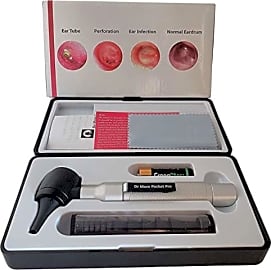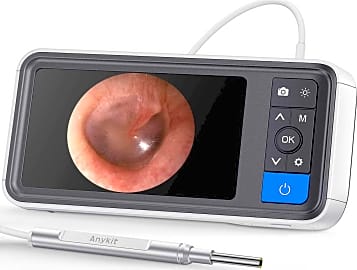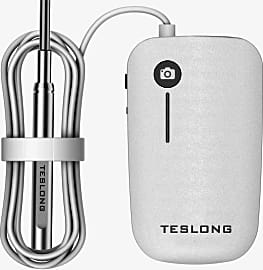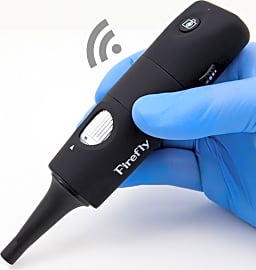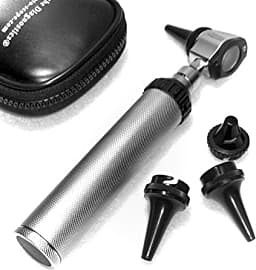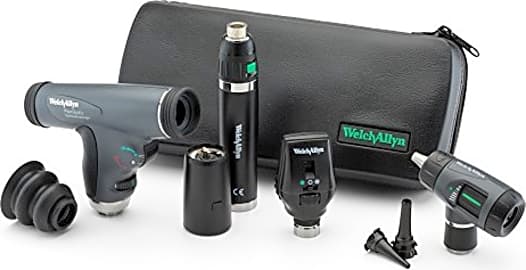The 10 Best Otoscopes

This wiki has been updated 41 times since it was first published in December of 2016. If you're a doctor or veterinarian, having an illuminated and unobstructed view of the inside of your patients' ears is essential when performing routine checkups, diagnosing auditory canal problems, or determining effective treatments. Equipped with multiple specula and dependable light sources, our selection of otoscopes provides the clarity and precision needed to quickly spot potential issues. When users buy our independently chosen editorial choices, we may earn commissions to help fund the Wiki.
Editor's Notes
December 09, 2020:
We've removed the Heine Mini-3000, Alpha Med Otoscopy Set, Serenelife 2-in-1, and Essentrapy SpecV3 due to availability concerns.
This year's additions include a few more high-tech options, including the Anykit Digital and Teslong Ear Camera, the former of which comes with its own dedicated color monitor and a 32-gigabyte memory card, so you can easily capture, display, and save screenshots and videos of the ear canal while the latter works with both Apple and Android mobile devices.
Also newly added is the Dr Mom Professional, which is a fourth-generation release at an affordable price offering online access to 30 photos of healthy and infected eardrums. Both this one and the Dr Mom Pocket for pets come with lifetime warranties.
The ADC Diagnostic Set and Welch Allyn Premium Kit come with ophthalmoscopes in addition to otoscopes, so they're well suited for use in a doctor's office. The former is equipped with an insufflator port for pneumatic otoscopy, while the latter includes a built-in throat illuminator.
August 23, 2019:
Just as a stethoscope is a precision tool that's used for listening to heartbeats and other sounds of the human (or animal) body, so is the otoscope when it comes to diagnosing problems inside the ear canal and around the eardrum of both humans and canines. One major difference between the otoscope and stethoscope, however, is that the otoscope commands use of additional components to make it compatible with varying ear shapes among dogs and humans. This also means that the otoscope is an extremely versatile tool. Thanks to the advances in technology, an otoscope is no longer limited to just live observation by a doctor, but many models can capture high-definition imagery of the inside of the ear canal, which doctors can use to diagnose problems and determine appropriate treatment.
For example, the Firefly DE551 comes with intuitive software capable of capturing both photos and videos of the inside of Fido's ear, meaning your vet doesn't have to spend an eon poking around in there to see if the animal has a medical condition. It is also equipped with four adjustable LEDs. The Essentrapy SpecV3 makes use of fiber optic technology, which helps to give doctors a wider field of view than most pneumatic otoscopes. This means a patient can be properly diagnosed in fewer appointments. Anyone with a child can probably attest to the fact that going to the pediatrician is no fun, especially when the need for return visits is due to the use of low-precision instruments. This model also comes with a pack of 20 specula. Furthermore, the less invasive an instrument appears, the less it may scare your kid. That makes the ScopeAround Digital a worthy contender for both junior and Rex, thanks to an extremely thin four-millimeter diameter and built-in high-definition camera. I also included the Serenelife 2-in-1 for its adjustable viewing aperture and ability to examine both the mouth and nose. Despite its very steep price, the Welch Allyn Premium is an ideal kit for the doctor in your family, as it comes with a throat illuminator and ophthalmoscope. The ADC Proscope has a bayonet locking head, rheostatic power switch, and a satin-finished handle with a knurled texture for a secure grip. I also added the Alpha Med Ostoscopy Set because of its integrated dimmer for precise control over its light intensity. Finally, I added the shockproof Heine Mini-3000, as it comes with an insufflation port for testing a patient's degree of tympanic mobility.
Special Honors
Amico DS-UR1 Good for hospitals, clinics, and other small healthcare facilities, the Amico DS-UR1 is a medical-grade diagnostic station that includes a halogen coaxial ophthalmoscope and LED fiber optic otoscope. These tools are housed atop a large, five-legged rolling base with an integrated basket for additional accessories. Its patented smart bulb system automatically turns off power to its light bulb to save energy when not in use. The otoscope has a swiveling lens for easy access and is compatible with insufflation bulbs. amico.com
Wispr Digital Increase the accuracy and efficiency of your ear exams with the easy-to-use Wispr Digital. This one is compatible with many industry standard power handles and features an integrated LCD touchscreen, intuitive user interface, namo camera, single-button image and video capturing functionality, and an anti-fog coating at its tip. It also includes a built-in USB port for downloading and transferring recorded images. wispr.com
Scoping Out The Mysteries Of The Ear
As its name suggests, the pocket otoscope easily slips into a lab coat pocket, making it an ideal tool for the doctor who's always on the go.
Whether you're a healthcare professional or running a veterinary practice for Fido, you use diagnostic tools to find signs of potential problems inside your patients' bodies. For example, a doctor uses a stethoscope's hollow tubing and earpieces to listen to the high-frequency sounds produced by a patient's heartbeat. But what happens when the patient's ears are the topic of concern? In much the same way as the stethoscope is a standard diagnostic tool for annual checkups, so is the otoscope when looking inside the human and canine ear to identify and treat medical issues.
The otoscope provides illuminated magnification of the inside of a patient's ear canal. Regardless of the type used, the device is equipped with several standard components. These include: the specula, specially shaped tools for gently probing and visualizing the ear canal; the head, which consists of an eyepiece and magnifying lens; a handle, containing an integrated power switch; an internal battery, responsible for supplying power to the device; and a light source. The light with which an otoscope is equipped can take the form of halogen, xenon, LED, or even fiber optic illumination.
Otoscopes fall into three main categories: pocket, full-size, and video. As its name suggests, the pocket otoscope easily slips into a lab coat pocket, making it an ideal tool for the doctor who's always on the go. The heads of most pocket otoscopes can be unscrewed to access their light sources when the time comes to replace them. Pocket otoscopes are powered by disposable AA alkaline batteries accessible through a cap on the bottom of their handles.
Setting the full-size otoscope apart from its smaller competition is the interchangeability of both its head and handle. The interlocking tool design from medical supply company Welch Allyn has made possible the attachment of different otoscope heads to the same handle. This means that a physician has the flexibility to attach a more advanced head to the same handle, upgrading certain components of the device without having to replace it entirely. Most full-size otoscopes are powered by rechargeable batteries, which means the user can plug the device into a standard wall outlet instead of relying on a reserve of disposable batteries.
The video otoscope is the most modern of all three types. Designed to interface with a computer monitor or television screen, this device captures both high-quality images and video inside the ear, projecting an enlarged view of the tympanic membrane that includes details of all its structures. Because it can be used to document the ear canal through images and video over time, the video otoscope is useful in determining the effectiveness of clinical procedures, such as the removal of cerumen.
Diagnosing Your Options
If your career path leads to the provision of hearing care in the medical world, consider all available features and options.
Size and weight are critical considerations when investing in an otoscope. If you have particularly large hands, then a full-size or video otoscope will work quite well for your needs. They are lightweight and easy to control, which simplifies the experience of performing an examination on a young child or fussy pooch.
Size and weight are critical considerations when investing in an otoscope.
Consider the source of power for your otoscope. Some offer wireless operation and run on rechargeable batteries, while others utilize wired configurations with wall-mountable power transformers.
Look for a device capable of pneumatic otoscopy. A pneumatic otoscope is equipped with an integrated port for an insufflation bulb that applies positive and negative air pressure to the eardrum. This delivery of air pressure allows you to determine how rigid or flexible a patient's eardrum is and whether that result could indicate a problem in need of treatment.
You must decide on the appropriate light source for your needs. For example, high-quality LED bulbs last for thousands of hours with an ability to distinguish a variety of colors observed within the ear canal. These colors indicate the overall health of the area under examination. That said, it's in your best interest to spend a little extra for a reliable source of illumination to ensure a proper diagnosis.
Finally, you must choose the type of specula that work best. Some doctors prefer to use disposable specula, as their otoscopes have built-in ejection systems that minimize direct contact with such contaminated components prior to their disposal.
A Brief History Of The Otoscope
The earliest concept of an otoscope dates back to the year 1363. French physician and surgeon Guy De Chauliac described his invention as a tong-shaped specula device used to examine both the nasal and aural passages of the human body.
While Gruber's design was never officially published, its operation was demonstrated to W.R. Wilde from Dublin, who further refined the device in 1844.
By 1838, Vienna native Ignaz Gruber developed the first funnel-shaped specula made entirely from metal. Unlike Chauliac's invention, Gruber's device had a relatively simple, conical shape that wasn't separated by a pair of jaws. While Gruber's design was never officially published, its operation was demonstrated to W.R. Wilde from Dublin, who further refined the device in 1844. It was at this point in time that ear speculum gained international acceptance as the standard means for examining the inside of a patient's ear.
The first pneumatic otoscope was invented in 1864 by German native E. Siegle. Siegle's device allowed for the examination of the eardrum as well as its response to variations in air pressure. This time period saw the incorporation of modern otoscope characteristics, including interchangeable ear specula, illumination of the ear canal using a perforated mirror, and a magnifying lens. All of these components were engineered into a single diagnostic instrument that we still know and use today.
Modern otoscope designs include advanced video and image capturing functionality along with completely wireless operation for increased freedom of movement around a doctor's office.


